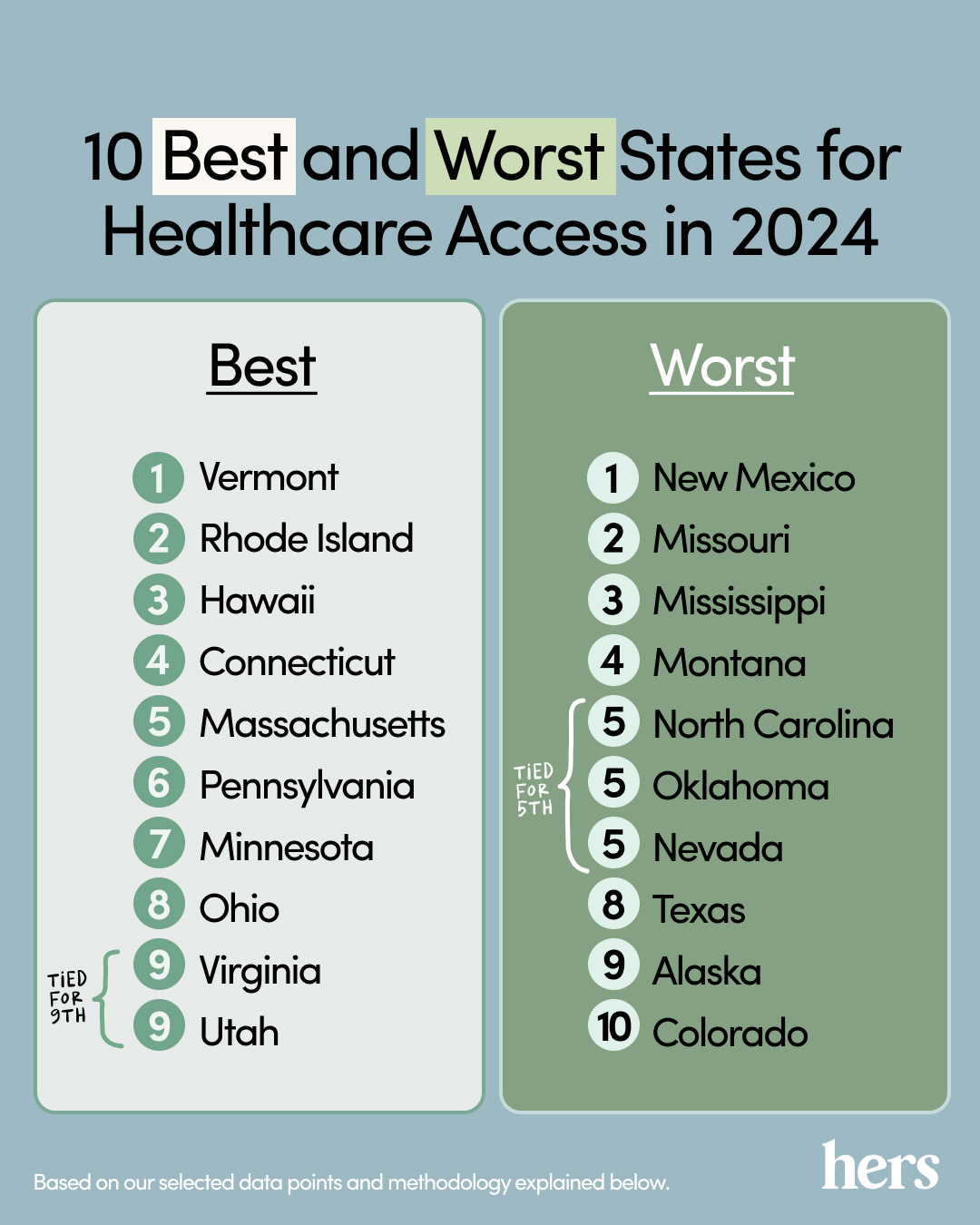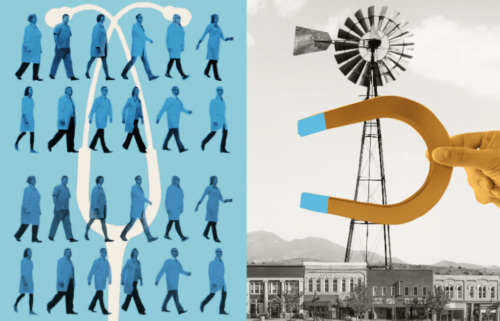These are the worst states for access to medical care

Sean Pavone // Shutterstock
These are the worst states for access to medical care
A view of Albuquerque, New Mexico’s skyline in the evening.
Equity in American healthcare is a work in progress. There are still some areas where it’s much easier and more convenient to access medical professionals and pharmacies. Improved access to care typically leads to better health outcomes, as well as an increased likelihood of people actually receiving preventative care and screenings.
Which states are falling short when it comes to accessible healthcare? Hers looked at four data sets to rank all 50 states from worst to best.
- Shortage of primary care physicians: Access to primary care physicians is an important part of the healthcare system. Research from the National Center for Health Workforce Analysis shows that using primary care results in better treatment of chronic conditions and an increased life expectancy.
- Percentage of population without health insurance coverage: Having health insurance coverage has a direct impact on health outcomes, including earlier prevention and screening services as well as better outcomes with diseases like cancer.
- Pharmacy access: Research shows that a lack of access to pharmacies is a major factor in medication nonadherence. Another study revealed that pharmacy closures resulted in an immediate decline in adherence among older U.S. adults taking cardiovascular medications.
- Access to medical specialists: Patients treated by specialists are shown to have better health outcomes compared to those solely treated by general practitioners.
Key Findings
- New Mexico ranks as the worst state for healthcare access, particularly when it comes to specialists and pharmacists. But it’s not all bad news. Albuquerque has one of the highest telehealth participation rates in the country, according to a 2024 Hers study. (Albuquerque residents are the most likely of any metropolitan area in the U.S. to identify as “youthful.”)
- New England and surrounding regions dominate the list of states with the best access to healthcare, with states like Vermont, Rhode Island, Connecticut, Massachusetts, and Pennsylvania on top.
- States with smaller population densities showed up on the list of worst states for healthcare access, including Alaska, Montana, and New Mexico.
- The three worst states for access to healthcare (Colorado, Alaska, and Texas) also had some of the lowest concentrations of physician specialists.
![]()

Hers
10 Best States for Healthcare Access
Infographic listing the 10 best and worst states for healthcare access in 2024.
1. Vermont
2. Rhode Island
3. Hawaii
4. Connecticut
5. Massachusetts
6. Pennsylvania
7. Minnesota
8. Ohio
9. Virginia, Utah (tied)
10 Worst States for Healthcare Access
1. New Mexico
2. Missouri
3. Mississippi
4. Montana
5. North Carolina, Oklahoma, Nevada (tied)
8. Texas
9. Alaska
10. Colorado
Worst States for Healthcare Access: Trends and Insights
Here are the best and worst states in each of the four categories analyzed: primary care shortages, percentage of population without health insurance coverage, the number of pharmacies per 100,000 residents, and access to specialist care.
Which States Have the Lowest Met Need for Access to Primary Care Professionals?
Many states have a shortage of primary care physicians, which impacts how quickly people are able to get medical attention or schedule preventative screenings. Hers looked at the percentage of need met in terms of primary care physicians for each state.
Least Amount of Primary Care Need Met
- Delaware
- Alaska
- Missouri
Greatest Amount of Primary Care Need Met
- Vermont
- New Hampshire
- Rhode Island
Which States Have the Least Amount of Health Insurance Coverage?
There is a major gap when it comes to health insurance coverage across the United States, which can hinder people from seeking medical care when they need it.
States With the Lowest Percentage of Health Insurance Coverage
- Texas
- Oklahoma
- Georgia
States With the Highest Percentage of Health Insurance Coverage
- Massachusetts
- Hawaii
- Vermont
Which States Have the Lowest Concentration of Pharmacies?
Not only are people more likely to stay on top of medication when a pharmacy is nearby, they also use pharmacists as healthcare resources. One study found that patients visit community pharmacies twice as often as other providers, demonstrating the importance of access.
States with the Lowest Number of Pharmacies Per 100,000 Residents
- Montana
- New Hampshire
- Illinois
States with the Highest Number of Pharmacies Per 100,000 Residents
- South Dakota
- Arizona
- Georgia
Which States Have the Fewest Medical Specialists?
Hers looked at the number of physician specialists per 100,000 residents in multiple disciplines, including psychiatry, surgery, anesthesiology, emergency medicine, radiology, cardiology, oncology, endocrinology, and other specializations.
States with the Fewest Medical Specialists Per 100,000 Residents
- New Mexico
- Missouri
- South Dakota
States with the Most Medical Specialists Per 100,000 Residents
- Pennsylvania
- Florida
- Wyoming
These rankings also mirror access to other types of specialists. Missouri has one of the lowest concentrations of OB-GYNs in the country, while Florida has one of the highest. Similarly, Florida has one of the highest concentrations of dermatologists in the country.
Access to Healthcare: 50 States Ranked from Worst to Best
Based on the criteria outlined, plus the methodology explained below, here are all 50 states ranked from worst to best in terms of healthcare access across the U.S.
1. New Mexico
2. Missouri
3. Mississippi
4. Montana
5. Nevada, North Carolina, and Oklahoma (tied)
8. Texas
9. Alaska
10. Colorado
11. Illinois
12. North Dakota
13. South Carolina
14. South Dakota
15. Idaho and Washington (tied)
17. Georgia
18. California
19. New Jersey
20. Wyoming and Oregon (tied)
22. Florida, Indiana, and Maryland (tied)
25. Michigan
26. Arizona and Delaware (tied)
28. New Hampshire and New York (tied)
30. Kentucky
31. Iowa, Tennessee, and Wisconsin (tied)
34. Kansas
35. Arkansas and Maine (tied)
37. Louisiana
38. Alabama and Nebraska (tied)
40. West Virginia
41. Utah and Virginia (tied)
43. Ohio
44. Minnesota
45. Pennsylvania
46. Massachusetts
47. Connecticut
48. Hawaii
49. Rhode Island
50. Vermont
Note: Based on data collected in August 2024. Get the data.
Data & Methodology
Hers based its rankings on four data categories related to health access.
- Percentage of primary care need met: Access to primary care helps with both prevention and treatment of health issues. Hers looked at data from the U.S. Department of Health & Human Services’ quarterly summary of Designated Health Professional Shortage Areas Statistics for the third quarter of 2024.
- Percentage of population without health insurance coverage: Hers used the U.S. Census Bureau‘s most recent data from 2022.
- Number of pharmacies per 100,000 residents: Hers compared the number of pharmacies in each state to the population, using data from the U.S. Census Bureau’s 2022 County Business Patterns.
- Number of specialist physicians: Using data from KFF—Professionally Active Specialist Physicians by Field, (KFF, May 2024)—Hers compared the total number of specialists to each state’s population to find which areas had the most and least access.
All categories were weighed equally. Each state was ranked individually in each category, then the average rank was used to determine final placement on the list.
What to Do If You Live in an Area Without As Much Access to Healthcare
Your health doesn’t have to take a backseat just because you live in an area with less access to medical care. Here are some strategies to make the most of health services no matter where you live to support healthy living.
- Access telehealth services: Utilizing telehealth can significantly increase access to certain types of care. Many telehealth companies also provide affordable services for those who don’t have insurance, providing people more options for affordable care no matter where they live.
- Be proactive with preventative care: Instead of waiting to visit a provider when you’re sick, plan ahead no matter your age or current level of health. Scheduling regular screenings and checkups can lead to earlier detection and treatment of chronic diseases like diabetes, Alzheimer’s, and osteoarthritis.
- Use a mail prescription service: Mail-order pharmacies make it easier and more convenient to manage prescriptions, especially if you don’t have a pharmacy nearby. You may even save on copays, especially if you’re managing a chronic condition with ongoing medication.
This story was produced by Hers and reviewed and distributed by Stacker Media.




